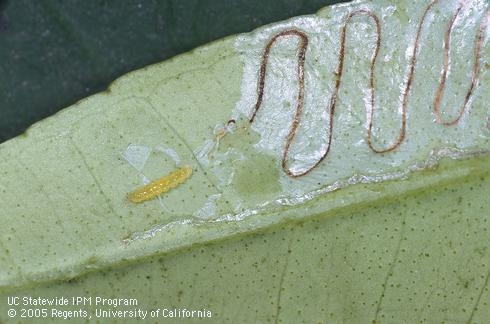Leafminers
By Leslie E. Stevens UCCE Master Gardener
I have little trails all over my lemon leaves. What do I do? Karen P. San Luis Obispo
Leafminers are best identified by what they leave behind – tiny, meandering trails on the undersides of young leaves. These mines are marked by thin dark lines of frass (feces) formed by newly hatched larvae feeding beneath the upper surface of leaf tissue. C
Citrus leafminer (Phyllocnistis citrella), a resident of California since 2000, confines itself to citrus trees (oranges, mandarins, lemons, limes, grapefruit) and close releatives such as kumquat and calamondin. Conversely, the serpentine leafminer attack a variety of flower and vegetable plants such as beans, peas, cole crops, tomatoes; begonia, dahlia, impatiens, petunia, and marigolds.
Adult citrus leafminers are tiny, light-colored, ¼-inch moths. The adult serpentine leafminer is a small black-and-yellow fly (Liriomyza species). Despite these differences, leafminers share many common traits.
They are most active in spring and summer months when tender new growth is abundant. Hot, inland temperatures tend to suppress populations, while mild coastal climates may extend leafminer seasons. The entire life cycle takes 3-7 weeks. Adults lay eggs on the underside of leaves. Eggs hatch after one week; larvae emerge and begin to feed just beneath the surface cells of leaf tissue, creating the telltale mines. Larvae molt, exit the mines, and roll the edge of the leaf. Within this curled leaf, larvae develop into pupae and emerge as adult moths.
Although leaf damage is unsightly, leafminers rarely threaten crops or overall plant health. Damage tends to be greatest on young trees, but will gradually decline as natural enemies become established. Insecticides are not recommended for leafminers. Young citrus trees may be the exception. Insecticides may be applied to new foliage when adult moths are present and laying eggs. Timing is important because chemicals are ineffective if applied when mining larvae are protected within leaf tissue. Manage leafminer populations the first couple years until the trees have sufficient leaf growth and are able to withstand pest damage. Other control strategies include removing water sprouts from trees to reduce leaf sites for leafminers to lay eggs and feed on. Also avoid applying leaf-stimulating nitrogen fertilizer when leafminer populations are high.
Always inspect plants for pests and disease prior to purchasing and planting.
